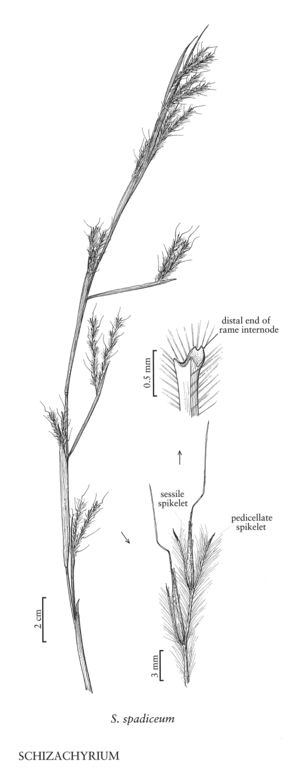Difference between revisions of "Schizachyrium spadiceum"
FNA>Volume Importer |
FNA>Volume Importer |
||
| Line 7: | Line 7: | ||
|synonyms={{Treatment/ID/Synonym | |synonyms={{Treatment/ID/Synonym | ||
|name=Andropogon spadiceus | |name=Andropogon spadiceus | ||
| − | |authority= | + | |authority= |
| + | |rank=species | ||
}} | }} | ||
|hierarchy=Poaceae;Poaceae subfam. Panicoideae;Poaceae tribe Andropogoneae;Schizachyrium;Schizachyrium spadiceum | |hierarchy=Poaceae;Poaceae subfam. Panicoideae;Poaceae tribe Andropogoneae;Schizachyrium;Schizachyrium spadiceum | ||
| Line 20: | Line 21: | ||
-->{{Treatment/Body | -->{{Treatment/Body | ||
|distribution=Tex. | |distribution=Tex. | ||
| − | |discussion=<p>Schizachyrium spadiceum was once thought to be a Mexican endemic, but it is now known from limestone slopes in Brewster County, Texas.</p> | + | |discussion=<p><i>Schizachyrium spadiceum</i> was once thought to be a Mexican endemic, but it is now known from limestone slopes in Brewster County, Texas.</p> |
|tables= | |tables= | ||
|references= | |references= | ||
| Line 29: | Line 30: | ||
-->{{#Taxon: | -->{{#Taxon: | ||
name=Schizachyrium spadiceum | name=Schizachyrium spadiceum | ||
| − | |||
|authority=(Swallen) Wipff | |authority=(Swallen) Wipff | ||
|rank=species | |rank=species | ||
| Line 37: | Line 37: | ||
|family=Poaceae | |family=Poaceae | ||
|illustrator=Linda A. Vorobik | |illustrator=Linda A. Vorobik | ||
| + | |illustration copyright=Utah State University | ||
|distribution=Tex. | |distribution=Tex. | ||
|reference=None | |reference=None | ||
| Line 42: | Line 43: | ||
|publication year= | |publication year= | ||
|special status= | |special status= | ||
| − | |source xml=https:// | + | |source xml=https://jpend@bitbucket.org/aafc-mbb/fna-data-curation.git/src/f50eec43f223ca0e34566be0b046453a0960e173/coarse_grained_fna_xml/V25/V25_1606.xml |
|subfamily=Poaceae subfam. Panicoideae | |subfamily=Poaceae subfam. Panicoideae | ||
|tribe=Poaceae tribe Andropogoneae | |tribe=Poaceae tribe Andropogoneae | ||
Revision as of 20:35, 16 December 2019
Plants cespitose. Culms 60-95 cm, slender, erect, glabrous. Leaves glaucous; sheaths compressed, scabridulous, glabrous or almost so; ligules 1-1.5 mm, truncate, erose-ciliate; blades 10-25 cm long, 2-2.5 mm wide, flat, scabrous, young blades ciliate basally. Peduncles 5-9 cm, mostly erect, often included in the subtending leaves, with 2 rames; rames 3.5-5 cm, enclosed or exerted at maturity; internodes 4-6.3 mm, ciliate proximally, densely villous on the distal 1/2 - 2/3, hairs 4-7 mm. Sessile spikelets 7-8 mm; calluses 0.2-0.5 mm, hairs 1-2 mm; lower glumes glabrous, keels scabridulous distally; awns 14.5-17.5 mm, once-geniculate. Pedicels 5-6 mm, hairs 5-7 mm. Pedicellate spikelets 0.8-4 mm, sterile, unawned. 2n = unknown.
Discussion
Schizachyrium spadiceum was once thought to be a Mexican endemic, but it is now known from limestone slopes in Brewster County, Texas.
Selected References
None.
